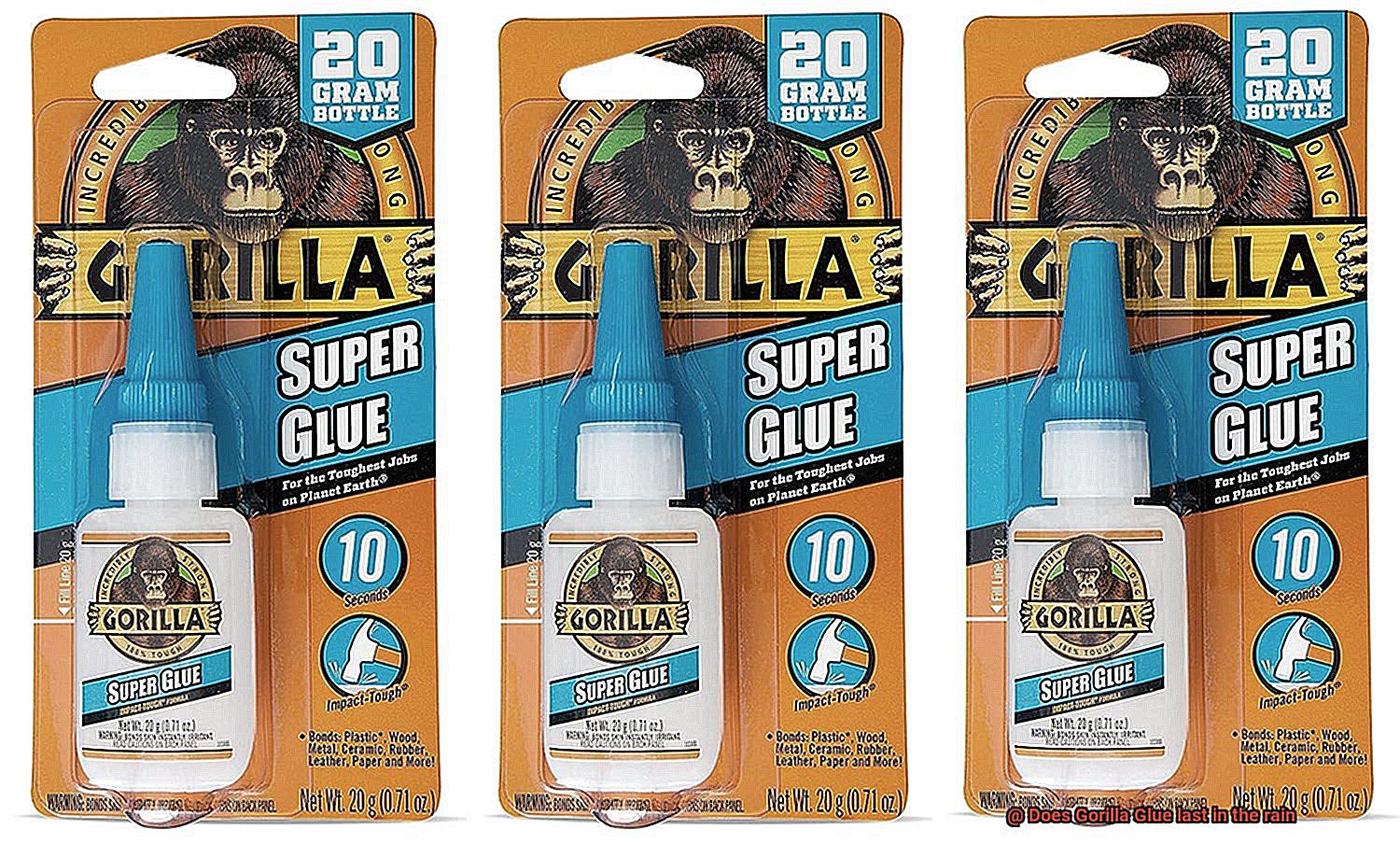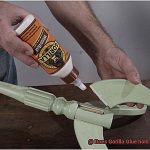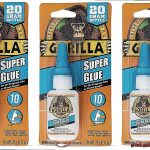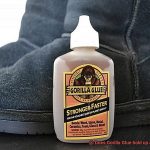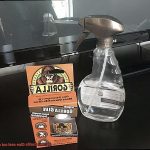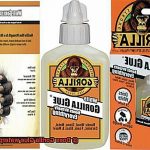Are you a DIY enthusiast who loves to work on projects rain or shine? If you’re planning to use Gorilla Glue, you might be wondering if it can withstand the rainy weather. Will your hard work go down the drain? Can Gorilla Glue maintain its adhesive strength when exposed to water? These are common questions that many DIYers ask themselves.
Gorilla Glue is a top-of-the-line polyurethane-based adhesive known for its industrial-grade strength and premium quality. It’s a go-to choice for professionals and DIYers alike, but how does it hold up under different weather conditions, especially in the rain?
In this blog post, we’ll dive deep into the science behind Gorilla Glue’s composition and how it reacts to water exposure. We’ll also share some tips on how to achieve the best possible result when using Gorilla Glue in damp or wet conditions. So sit tight and get ready to learn everything you need to know about Gorilla Glue and its effectiveness in the rain.
Is Gorilla Glue Waterproof or Water-Resistant?
Contents
- 1 Is Gorilla Glue Waterproof or Water-Resistant?
- 2 How to Prepare Surfaces for Gorilla Glue in Wet Conditions
- 3 Temperature Considerations When Using Gorilla Glue in Wet Environments
- 4 Can You Use Gorilla Glue on Wet Surfaces?
- 5 How Long Does Gorilla Glue Take to Cure in Wet Conditions?
- 6 Tips for Maximizing the Effectiveness of Gorilla Glue in Wet Environments
- 7 How to Protect Your Bond from Prolonged Exposure to Rainfall
- 8 Alternatives to Gorilla Glue for Waterproof Sealing
- 9 Conclusion
When it comes to adhesive options, Gorilla Glue is a popular choice for many projects and repairs. But if you’re planning to use it in areas that may be exposed to water or moisture, you might be wondering whether it’s waterproof or water-resistant. The answer, as it turns out, depends on the type of Gorilla Glue you’re using.
Let’s start with the Original Gorilla Glue. This polyurethane-based adhesive is known for its strength and durability, but it’s not completely waterproof. Although it can withstand some exposure to water, extended immersion or prolonged exposure can weaken the bond. So if you’re working on a project that requires constant moisture or submersion in water, you might want to look for a different type of glue.
On the other hand, Gorilla Wood Glue is designed specifically for woodworking projects and is a PVA-based adhesive. This type of glue is water-resistant and can withstand some exposure to water without losing its strength. However, it’s still not completely waterproof and shouldn’t be used for projects that will be exposed to constant moisture or submerged in water.
It’s important to note that even though Gorilla Glue isn’t completely waterproof, it can still provide a strong bond even in damp or humid conditions. This makes it an excellent choice for outdoor projects or repairs that may be exposed to some moisture.
When working with Gorilla Glue in wet conditions, there are a few things to keep in mind. First, ensure that the surfaces you’re bonding are clean and dry before applying the adhesive. Any moisture or debris on the surfaces can compromise the strength of the bond and reduce the effectiveness of the glue.
Furthermore, temperature can affect the curing process of the glue. It’s recommended to use Gorilla Glue in temperatures between 50-90°F (10-32°C) and allow at least 24 hours for the glue to fully cure.
How to Prepare Surfaces for Gorilla Glue in Wet Conditions
If you’re planning to use Gorilla Glue in wet conditions, it’s important to prepare your surfaces properly to ensure a strong and long-lasting bond. Here are five steps you can take to prepare your surfaces for Gorilla Glue in wet conditions:
Thoroughly clean the surface
The first step is to make sure the surface is clean and free of any dirt, dust, or debris. Use a damp cloth or mild detergent to remove any stubborn stains, but be careful not to oversaturate the surface with water. If the surface is too wet, use a dry cloth to soak up any excess moisture.
Roughen up the surface
To create a better bonding surface for the glue, use sandpaper or a wire brush to roughen up the surface slightly. This is especially important if the surface is smooth or non-porous.
Dry out wet wood
If you’re working with wet wood, try to dry it out as much as possible before applying the glue. This can be done by leaving the wood in a warm, dry place for a few days or using a dehumidifier. Wet wood can be more difficult to glue than dry wood, so this step is crucial.
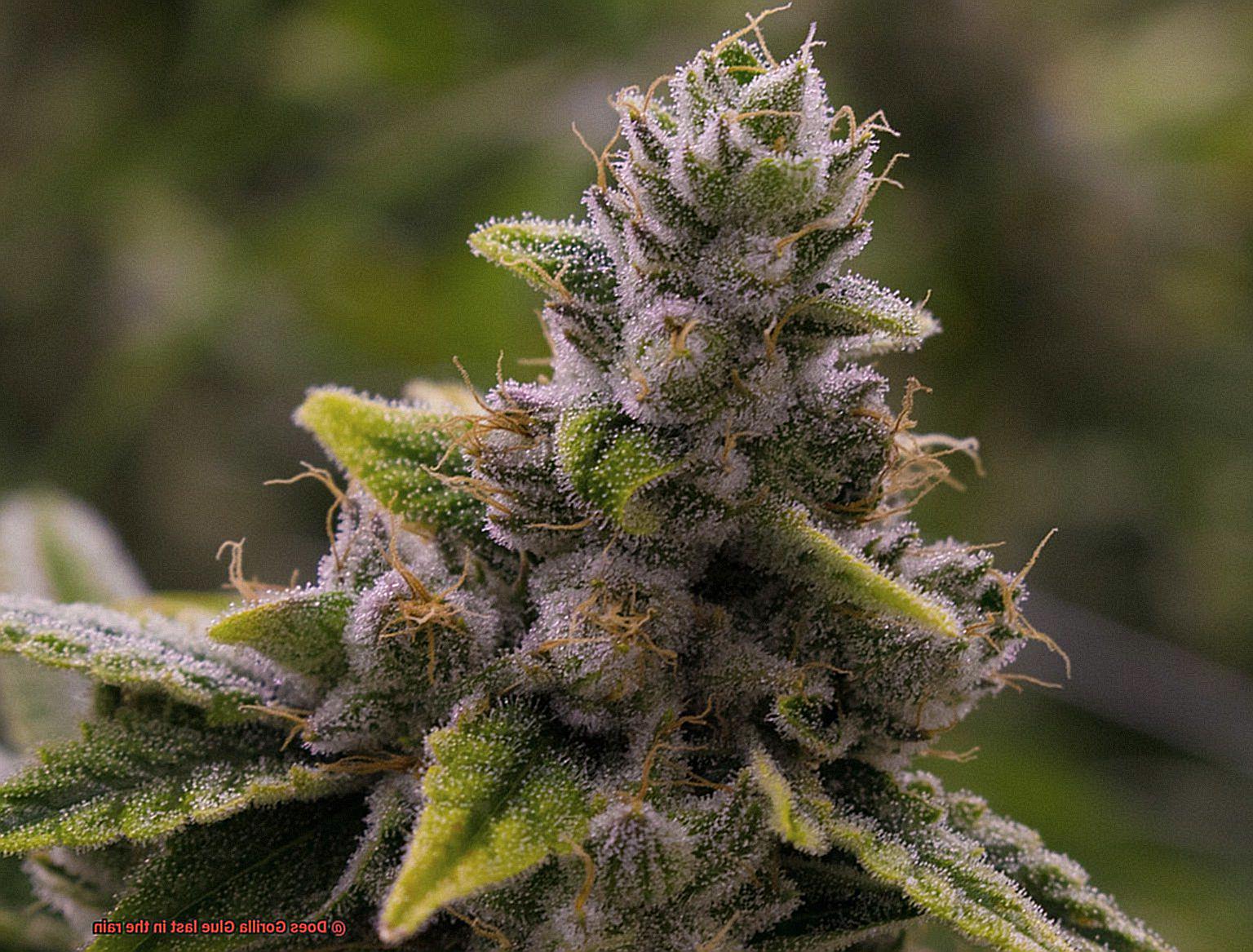
Use a primer if necessary
If you’re working on a particularly smooth or non-porous surface, you may need to use a primer before applying the Gorilla Glue. This will help to create a stronger bond and ensure that the glue adheres properly.
Apply the glue to both surfaces
To achieve the strongest bond possible, apply the Gorilla Glue to both surfaces that are being bonded together. This means that you should apply the glue to one surface and then press the two surfaces together firmly.
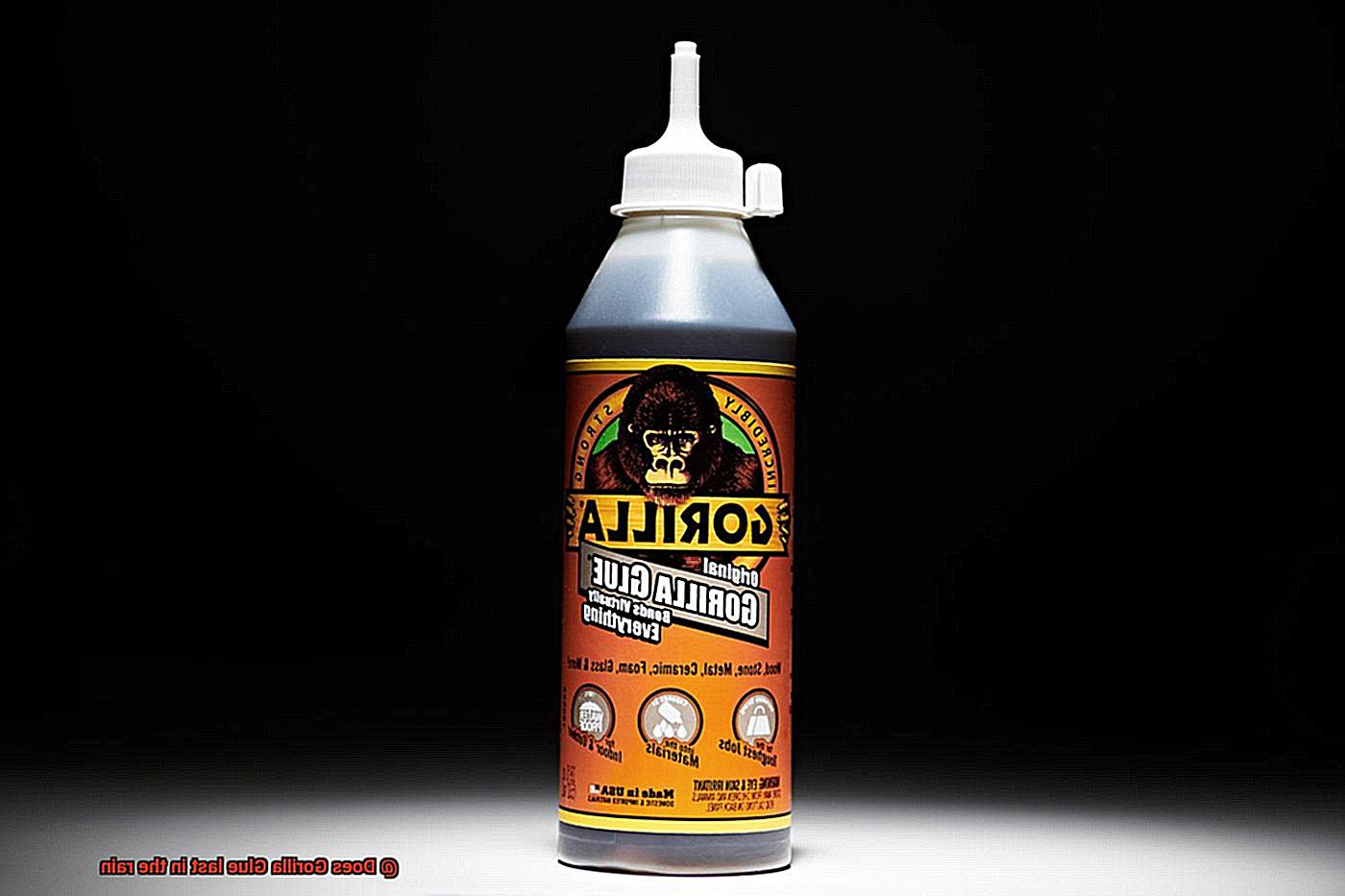
It’s also important to allow enough time for the glue to dry completely before exposing it to any moisture. Depending on the conditions, this can take anywhere from 24-48 hours. Be sure to plan accordingly and allow enough time for the glue to fully cure before using the bonded object.
Temperature Considerations When Using Gorilla Glue in Wet Environments
When it comes to using Gorilla Glue in wet environments, temperature is a vital factor that can make or break your bond. Gorilla Glue is formulated to work best at room temperature, around 77°F or 25°C. If the temperature falls below this range, the curing process will take longer, while higher temperatures can cause the glue to dry too quickly or not bond as strongly.
But what about when moisture is present? Well, things can get even more complicated. Freezing temperatures can make water expand, which can potentially break apart even the strongest glue joint. On the other hand, if the temperature is too hot, the glue may soften and lose its grip, creating a weak bond.
To ensure that your Gorilla Glue bond lasts in wet environments, it’s crucial to choose a location with consistent temperatures within the recommended range. Keeping the area as dry as possible and avoiding exposure to water until the glue has fully cured is also important. For extra protection against moisture, consider using a waterproof sealant or coating over the glue joint.
Here are a few tips to keep in mind when using Gorilla Glue in wet environments:
- Choose a location with consistent temperatures within the recommended range
- Keep the area as dry as possible
- Avoid exposing the glue joint to water until it has fully cured
- Consider using a waterproof sealant or coating for extra protection

Can You Use Gorilla Glue on Wet Surfaces?
The answer is yes, but with some important considerations. Gorilla Glue is actually activated by moisture, which means that it can work better on wet surfaces than on dry ones. However, it’s important to take proper precautions to ensure a strong bond.
Here are some tips to keep in mind when using Gorilla Glue on wet surfaces:
- Remove excess moisture: To ensure the glue can dry and cure properly, remove as much moisture as possible from the surface before applying the glue. Use a towel or other absorbent material to dry off the surface thoroughly.
- Use heat to dry the surface: If there is still some moisture left on the surface, use a hairdryer or heat gun to dry it off before applying the glue. Be careful not to overheat the surface, as this can cause damage or warping.
- Avoid completely submerged surfaces: It’s not recommended to use Gorilla Glue on surfaces that are completely submerged in water. The glue needs air to dry and cure properly, so it won’t be able to do so if it’s constantly exposed to water.
How Long Does Gorilla Glue Take to Cure in Wet Conditions?
Gorilla Glue is a remarkable adhesive that can handle a wide range of bonding applications, including wet conditions. However, the curing time is an essential factor that can affect the strength and durability of the bond. As an expert in this field, I am here to provide you with valuable information on how long Gorilla Glue takes to cure in wet conditions.
To start, it’s important to understand that Gorilla Glue is activated by moisture, which means it requires water to bond and cure properly. Therefore, it’s recommended to apply the glue to a damp surface for optimal results.
According to the manufacturer’s instructions, Gorilla Glue requires 10-45 minutes of clamp time and 24 hours of curing time for a full bond to form. However, keep in mind that this timeframe may vary depending on the temperature, humidity, and amount of moisture present in the environment.

In wet conditions, it may take longer for Gorilla Glue to cure due to the increased moisture content. Additionally, if applied to a damp or wet surface, the glue may take longer to dry. Therefore, it’s important to remove excess moisture and use heat to dry the surface if necessary (but don’t overdo it).
To ensure a robust and durable bond, keep the glued surfaces dry and free from moisture during the curing process. This can be accomplished by using fans or heat lamps to create airflow or by placing the object in a dry environment like an oven.
It’s worth noting that Gorilla Glue is not recommended for continuous submersion in water or extreme wet conditions as prolonged exposure can cause the bond to weaken or break over time. Instead, it’s best used for occasional exposure to water.
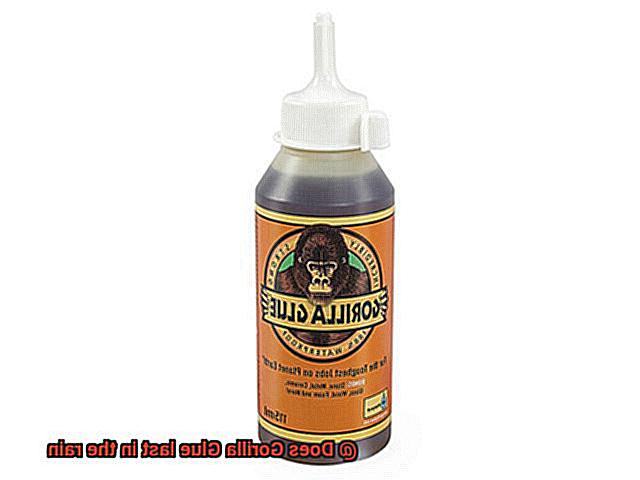
In conclusion, Gorilla Glue can be used in wet conditions as long as proper curing time is allowed and the surfaces are kept dry during the bonding process. Follow these guidelines for optimal results:
- Apply glue to a damp surface
- Remove excess moisture
- Use heat to dry the surface if needed
- Keep glued surfaces dry during the curing process
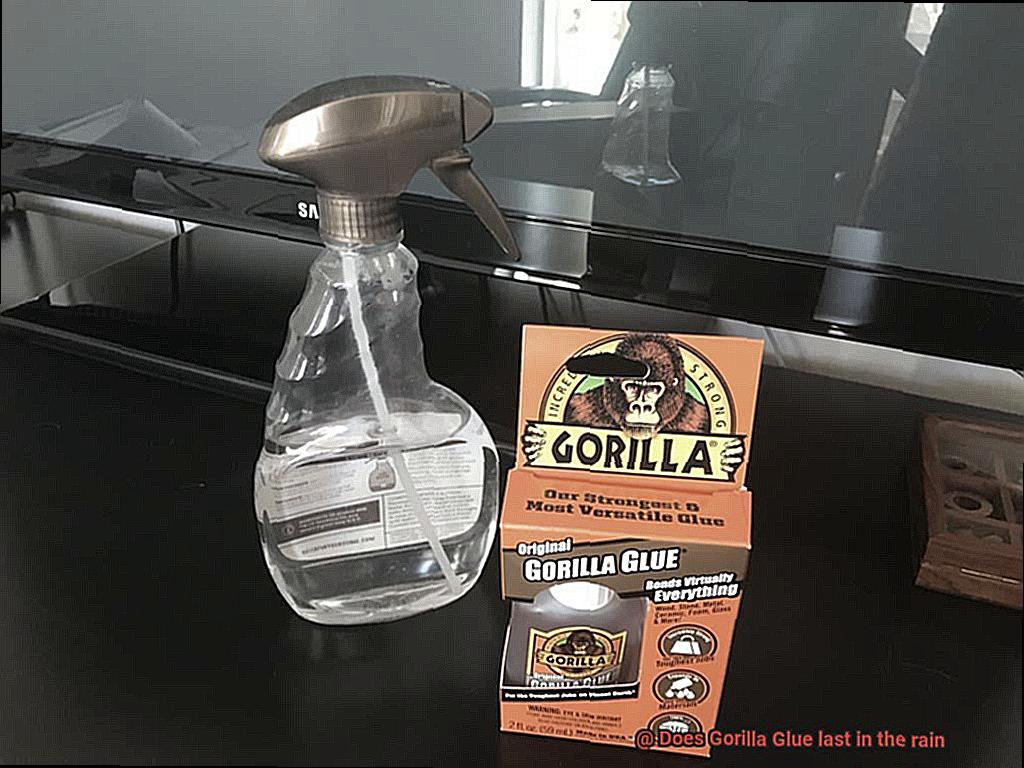
Tips for Maximizing the Effectiveness of Gorilla Glue in Wet Environments
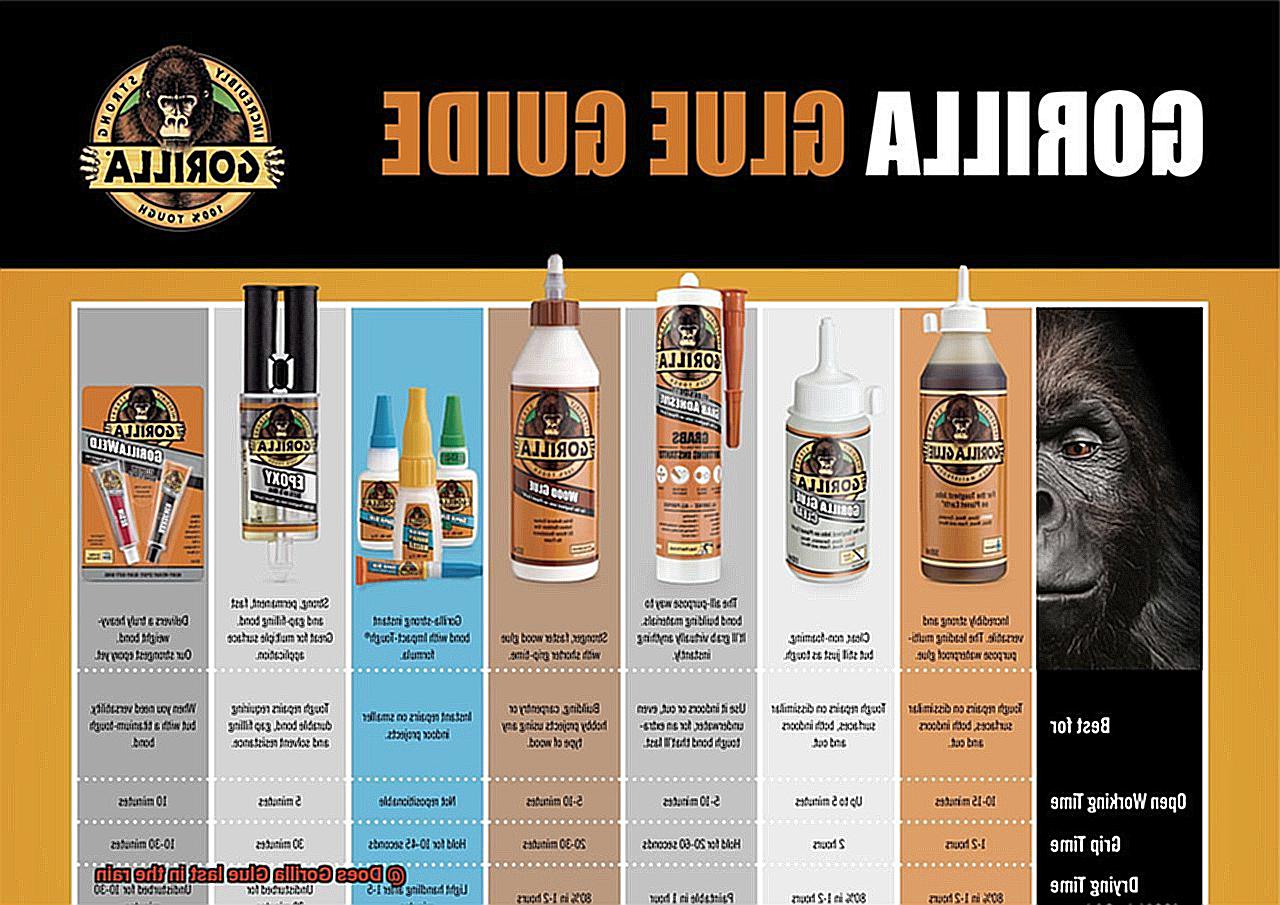
Using Gorilla Glue in wet environments can be a bit tricky, but by following these tips, you can maximize its effectiveness and ensure a strong bond between surfaces even in rainy conditions.
Clean and Dry Surfaces:
The first step is to ensure that the surfaces you plan to bond are clean and dry.
Any moisture or debris on the surfaces can compromise the strength of the bond and reduce the effectiveness of the glue.
Wiping the surface with a dry cloth or paper towel can help remove any water droplets and ensure a clean surface for bonding.
Use Waterproof Gorilla Glue:
Consider using a waterproof variant of Gorilla Glue such as Gorilla Wood Glue or Gorilla Super Glue Gel. These specialized adhesives are designed to withstand water exposure and can provide a completely waterproof seal.
Apply Enough Glue:
When applying Gorilla Glue in wet environments, make sure to use enough glue to ensure a strong bond. Applying a thin layer may not be effective as the glue may not penetrate deep enough into the surfaces being bonded. A thick layer of glue will also take longer to dry, so finding the right balance is crucial.
Clamp or Hold Firmly:
It is essential to clamp or apply pressure on the bonded surfaces until the glue dries completely. This will help prevent any movement or separation of the surfaces during the drying process. Using clamps or weights to hold the surfaces together will ensure a strong bond that can withstand water exposure.
Allow Extra Drying Time:
Gorilla Glue takes longer to dry in wet environments as compared to dry ones. Therefore, it is recommended to allow for extra time for the glue to dry completely before exposing it to any moisture or water. This extra drying time will ensure that the bond is strong enough to withstand water exposure and prevent any damage.
How to Protect Your Bond from Prolonged Exposure to Rainfall
Rain can be beautiful, but it can also be a nightmare for your bonded projects. The last thing you want is for your bond to weaken or break down due to prolonged exposure to rainfall. To prevent this, there are several steps you can take to protect your bond and extend its life.
Clean and Dry Surfaces
The first step in protecting your bond from prolonged exposure to rainfall is to ensure that the surfaces you’re bonding are clean and dry. Any dirt or moisture on the surfaces can weaken the bond over time, so it’s essential to clean and dry the area thoroughly before applying Gorilla Glue.
Seal It Up
One way to protect your bond from water damage is by using a sealant around the edges of your project. This will create a barrier that helps prevent water from seeping into the bond and causing it to weaken over time. It’s crucial to choose a sealant that is compatible with Gorilla Glue for optimal results.
Waterproof Coating or Spray

Another option to protect your bond from rainfall is by using a waterproof coating or spray on your project after it has fully cured. This will add an extra layer of protection against moisture and help extend the life of your bond. Be sure to choose a waterproofing spray that is compatible with Gorilla Glue and follow the manufacturer’s instructions carefully.
Cover It Up
If possible, consider covering your project or placing it under shelter to protect it from prolonged exposure to rain. This can be especially important for outdoor projects or items that will be exposed to the elements.
Check for Compatibility
It’s important always to check for compatibility when choosing sealants or waterproofing sprays. Some products may not work well with Gorilla Glue and could compromise the bond, leading to potential damage.
Alternatives to Gorilla Glue for Waterproof Sealing
There are other options that can provide the same level of durability and resistance to water. Let’s dive into some of these alternatives.
First off, marine epoxy is a specific type of adhesive designed to withstand water and can be used on a variety of surfaces, making it an excellent choice for sealing leaks in boats or aquariums. Its versatility and strength make it a great option for DIY projects in wet environments.
Another alternative is polyurethane adhesive. This type of glue is well-known for its bonding ability with various surfaces and its resistance to water exposure. It’s commonly used in construction projects and can hold its own against Gorilla Glue when it comes to waterproof sealing.
For those looking for something flexible and adaptable, silicone sealant may be the way to go. This adhesive can be used on surfaces ranging from glass to metal to plastic, making it a fantastic choice for bathrooms and kitchens where mold and water damage are common.
Lastly, don’t forget about super glue, also known as cyanoacrylate glue. While not as strong as some of the other options listed above, it can still provide adequate sealing for small projects and repairs. Plus, it dries quickly and is easy to use.
Also Read: Is Gorilla Super Glue Waterproof?
Conclusion
In conclusion, Gorilla Glue is a reliable and versatile adhesive that can hold up against some exposure to water and moisture. However, it’s important to keep in mind that not all types of Gorilla Glue are created equal when it comes to waterproofing. The Original Gorilla Glue is incredibly strong and durable, but it’s not recommended for projects that require constant exposure to moisture or submersion in water. On the other hand, Gorilla Wood Glue is specifically designed for woodworking projects and boasts water-resistant properties.
When using Gorilla Glue in damp conditions, it’s essential to prepare surfaces properly by thoroughly cleaning and drying them before application. Additionally, temperature plays a significant role in the curing process, so be sure to take into account any fluctuations in temperature during the drying period.
If you’re looking for alternatives to Gorilla Glue for waterproof sealing, there are several options available depending on your project needs. Marine epoxy, polyurethane adhesive, silicone sealant, and super glue are all viable alternatives.
Overall, with proper preparation and application techniques, Gorilla Glue can provide a strong and long-lasting bond even in wet environments.

